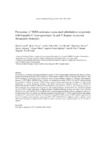Prevalence of NS5A resistance associated substitutions in patients with hepatitis C virus genotypes 1a and 3: Impact on current therapeutic strategies

Ver/
Use este enlace para citar
http://hdl.handle.net/2183/20798Coleccións
- INIBIC-VC - Artigos [39]
Metadatos
Mostrar o rexistro completo do ítemTítulo
Prevalence of NS5A resistance associated substitutions in patients with hepatitis C virus genotypes 1a and 3: Impact on current therapeutic strategiesAutor(es)
Data
2018-02-10Cita bibliográfica
Grandal M, Pernas B, Tabernilla A, Mariño A, Álvarez H, Valcarce N, et al. Prevalence of NS5A resistance associated substitutions in patients with hepatitis C virus genotypes 1a and 3: Impact on current therapeutic strategies. J Med Virol. 2018;90(6):1094-1098
Resumo
[Abstract] The presence of resistance‐associated substitutions (RASs) at NS5A region might compromise the efficacy of Direct Acting Antiviral agents (DAAs). HCV resistance at NS5A region is mainly focused on patients with hepatitis C virus (HCV) genotypes 1a (G1a) and 3 (G3) with other factors of poor treatment response (ie cirrhosis, prior treatment‐exposure, or HCV‐RNA >800 000 IU/mL). Herein, we evaluated in a cohort of HCV G1a and G3 infected patients the prevalence of RASs at domain I NS5A using population‐based sequencing and the impact of RASs on the optimization of current therapeutic strategies. The RASs considered as clinically relevant were: M28A/G/T, Q30D/E/H/G/K/L/R, L31M/V/F, H58D, and Y93C/H/N/S for G1a and Y93H for G3. A total of 232 patients naïve to NS5A inhibitors were included (166 G1a, 66 G3). The overall prevalence of NS5A RASs for G1a and G3 patients was low (5.5%) or null, respectively. A high proportion of patients harbored, at least, one factor of poor response (78.9% for G1a, and 75.8% for G3). Overall, the rates of patients harboring NS5A RASs in combination with any of the other factors were low and the vast majority of patients (G1a> 94% and G3 100%) could be treated with standard treatments of 12 weeks without ribavirin. In conclusion, testing NS5A RASs in specific HCV‐infected populations (ie G1a & G3, cirrhosis, prior treatment experienced, HCV‐RNA >800 000 IU/mL) might be useful to optimize current NS5A‐based therapies avoiding ribavirin‐related toxicities, and shortening treatment duration in the majority of patients.
Palabras chave
Genotype 1a
Genotype 3
HCV-infection
NS5A
RASs
Genotype 3
HCV-infection
NS5A
RASs
Versión do editor
Dereitos
This is the peer reviewed version of the article which has been published in final form at Wiley Online Library. This article may be used for non-commercial purposes in accordance with Wiley Terms and Conditions for self-archving.
ISSN
0146-6615
1096-9071
1096-9071





